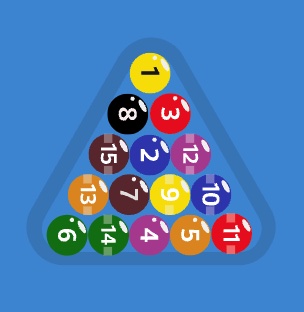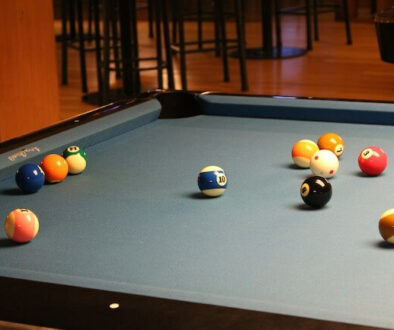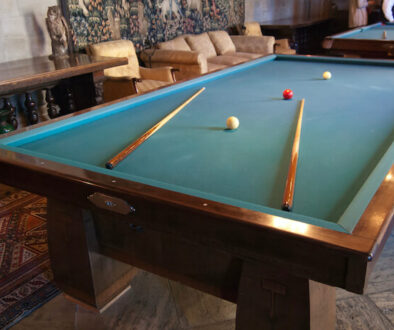Cutthroat Pool: The Best 3-Player Pool Game on the Planet
As pool players, we are pretty spoiled when it comes to the variety of games we can play on a pool table. But, the majority of billiards games are only 2 player games. In this sense, pool can be limiting when you have more friends or family around that want to play.
There is one billiards game that bucks this trend and makes it possible to play with more than 2 players – Cutthroat pool. Cutthroat is a pretty easy-to-understand game, and we’re here to help explain everything you’ll need to know before playing. Let’s start by going over how to play Cutthroat.
How to Play Cutthroat Pool
When playing Cutthroat, the main objective is to make your opponents’ groups of balls and clear them off the table, while leaving some, or all of your balls on the table at the end. Cutthroat is typically a 3-player pool game, and can theoretically be played with 5 players as well. The player count just needs to be a factor of 15, because there are 15 balls used while playing.
How to Rack Cutthroat Pool
To rack a game of Cutthroat, you will use a typical triangle billiards rack since the game involves all 15 object balls.
For ball position, Cutthroat requires the 1 ball be at the top of the rack, and the 6 and 11 balls go in each corner. The rest of the balls can be placed randomly in the rack, and the 8 ball does not have to go in the middle.
See the racking example below!

Who Breaks in Cutthroat?
When playing cutthroat, it doesn’t matter who breaks. You can flip a coin twice between the 3 players to see who comes out on top, or you could play a game of rock, paper, scissors and see who wins.
Ideally, the person breaking should be able to hit the rack of balls fairly hard so that the balls spread out well across the table.
Cutthroat pool is more of an informal game, so, before breaking, you need to come to an agreement with the other players on whether or not you will be calling your shots during the game.
That way, there’s no confusion about whether or not slop shots are allowed (slop is when balls are made without being “called”). Check out this article for more in-depth info on slop in pool!
Determining Ball Assignments
There are really two main methods to figure out who gets what balls during cutthroat pool.
- Assign each person 5 balls before the break. One person will have balls 1 through 5, one person will have balls 6 through 10, and the last person will have balls 11 through 15.
- Pick your group of balls after pocketing a ball. If the person breaking makes a ball, that person can pick whichever group of 5 balls they want. The group they pick should not contain the ball they just made, since the objective of the game is to clear out the opponent’s balls.
When you pick your group of balls, you are trying to keep all those balls on the table and make the other 10 balls. Essentially, you want to protect your group of balls from being pocketed.
If you make a shot, you continue to try and knock other balls into pockets. If you miss a shot, the shot moves onto the next player.
How to Win a Game of Cutthroat
To win a game of Cutthroat pool, one player must pocket all of the other two groups of balls that aren’t assigned to them. The player cannot win if all their claimed balls have been pocketed. Once that happens, they are out of the game.
In order to increase your chances of winning, it can be a good strategy to play defensive shots and try to put your balls in difficult positions so it’s harder for your opponents to pocket them.
Cutthroat Pool Rules
You will find that many of the rules in Cutthroat are very similar to the rules in 8-ball. But we’ll make them super clear to you so you know exactly what to expect during play.
In this section, we’ll discuss legal shots and scratches/other fouls.
I. Legal Shots in Cutthroat Pool
If you have been assigned a group of balls, you can’t hit your own ball first when playing Cutthroat. You must strike your opponent’s ball with the cue ball first. So, if you need to play defense at any point, it’s easiest to hit another player’s ball close to your ball so it’s locked up, and harder to make.
After striking an object ball, the cue ball or the object ball must hit a rail after the shot. If no balls hit the rail, the next player gets to spot the ball behind the head string to make their next shot.
II. Scratches and Fouls in Cutthroat
Scratching:
A scratch is when the cue ball is pocketed, or when it is hit off the table. This is an illegal shot in Cutthroat, and results in the next player getting to place the ball behind the head string, or “kitchen”.
If you have a ball-in-hand shot where you can’t strike an object ball because they are all behind the head string, you have the option to spot one of them at the other end of the table at the top of the rack position.
Fouls:
You may not contact your ball first in the process of making an opponent’s ball. This results in a foul. Any opponent ball you made illegally gets re-spotted back on the table, and you don’t get rewarded for it.
If you accidentally jump any ball off the table, this results in a foul as well, and you lose your turn.
Cutthroat Pool Rules Summary
Here are the main things you need to remember when playing Cutthroat pool.
- It doesn’t matter who breaks during the initial game
- If play continues after the first game, the winner breaks
- Players can’t hit their own group of balls first when taking a shot
- After contacting a ball, the cue ball or object ball must hit a rail
- After a scratch, the next player places the cue ball on the head string
- Player may spot an object ball if all balls are behind the head string following a scratch
- An object ball made illegally gets spotted back on the table
- Jumping a ball off the table is a foul
Why Should You Play Cutthroat Pool?
You should play cutthroat pool if you want a fun experience, but don’t play tons of pool. If you don’t consider yourself a great player, Cutthroat is an awesome option. When the game is played by those who aren’t top notch pool players, it lasts longer and plays fairly.
If you are playing Cutthroat with someone who is really good at pool, you can make a rule that requires them to make all their opponent’s balls in numbered order. This will create more of a challenge for them and they likely won’t be able to run the ball out near as easily.
Cutthroat is a great change of pace game, and is more laid back which creates a less stressful atmosphere. This game is also beneficial when you have an odd number of people who want to play. It can create some great entertainment with friends and family.
Cutthroat will also help you improve and understand defensive strategies, since you have to protect your 5 balls from being made. Just know that when you play defense or safeties, you need to make sure to hit a rail with a ball.
Wrap Up
Cutthroat pool is a really fun alternative to the regular pool games like 8 ball or 9 ball. It’s typically a 3-player game, keeps pool fun and you’ll learn something new by playing.
We enjoyed sharing the strategies and rules for cutthroat pool, and hope you can put them into practice soon!
As always, Happy Shooting!




